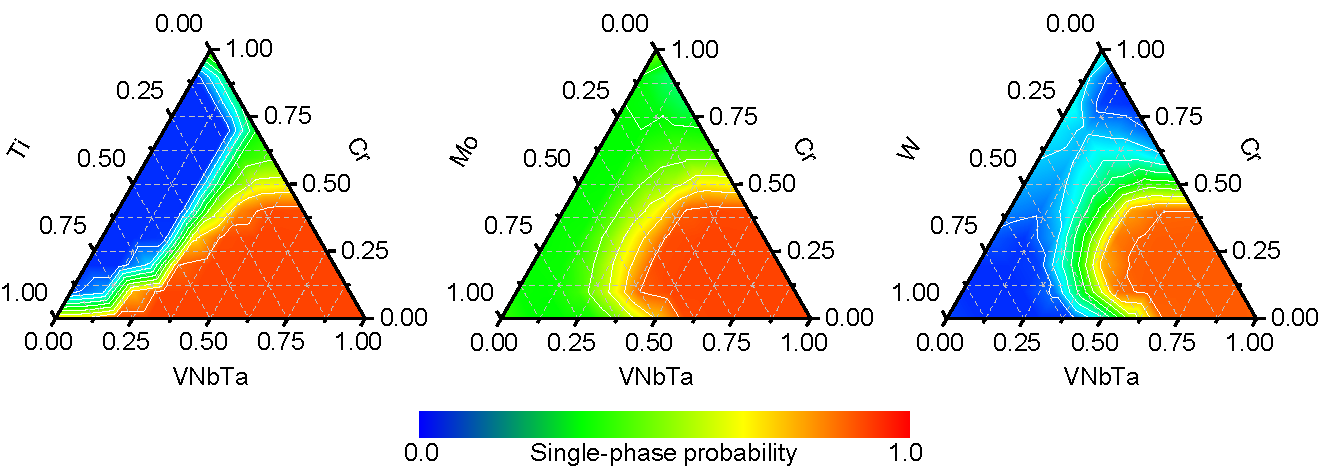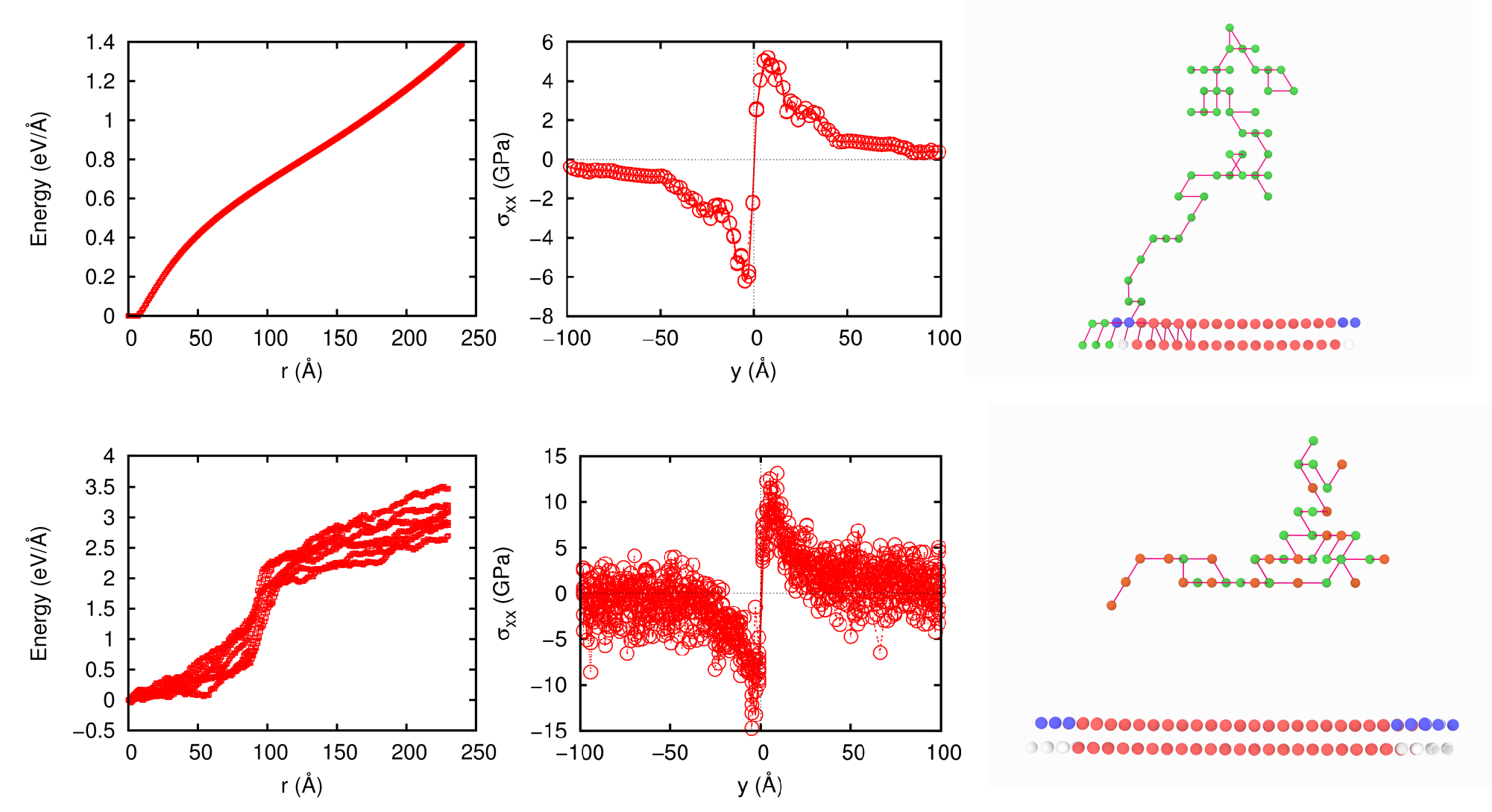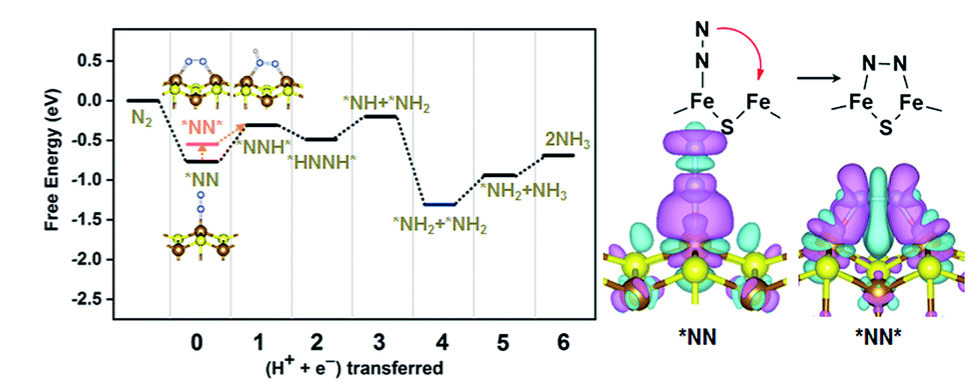Research
We are a dynamic and vibrant group working on Computational Materials Science. We study how different materials respond to external conditions, such as mechanical deformation and irradiation damage. For this purpose, we combine various computational techniques to probe the different materials processes at the electronic and atomic levels. We are particularly interested in developing and applying start-of-art methodologies to understand materials properties, such as machine learning and materials informatics.
Here are some themes that we currently work on:
Effects of disorder on properties of high-entropy alloys
The development of high-entropy alloys has greatly stimulated the concept of multi-principal elemental alloys (MPEAs) that revolutionized materials design strategy. For MPEAs, the random arrangement of different elements leads to extreme chemical disorder and complexity. Understanding the role of chemical complexity and engineering the disordered state is vital for the further development of MPEAs with outstanding properties such as mechanical strength and irradiation resistance. Aiming to establish the link between chemical disorder and materials performance, we have studied the nature of the disorder and local order, the influence of disorder on defect properties, and the effects of disorder on mechanical deformation and defect evolution in novel FCC and BCC MPEAs and intermetallics.
– Shijun Zhao, Role of chemical disorder and local ordering on defect evolution in high-entropy alloys, Physical Review Materials 5, 103604 (2021).
– Shijun Zhao, G Malcolm Stocks, and Yanwen Zhang, Stacking fault energies of face-centered cubic concentrated solid solution alloys, Acta Materialia 134, 334 (2017)
– Shijun Zhao, Yuri Osetsky, and Yanwen Zhang, Preferential diffusion in concentrated solid solution alloys: NiFe, NiCo and NiCoCr, Acta Materialia 128, 391 (2017).

Design and development of high-entropy ceramics
High-entropy ceramics (HECs) are a new class of ceramics that exhibit extraordinary properties compared to conventional ceramics. IN HECs, the metallic sublattice consists of multiple principal components, resulting in partial disorder on only a sublattice. We have developed novel machine learning techniques to predict the single-phase formation ability of various HECs. To reveal the effects of disorder, we have also studied the role of chemical complexity on different properties of HECs.
– Jun Zhang, Biao Xu, Yaoxu Xiong, Shihua Ma, Zhe Wang, Zhenggang Wu, Shijun Zhao, Design high-entropy carbide ceramics from machine learning, npj Computational Materials, 8, 1 (2022).
– Shijun Zhao, Lattice distortion in high-entropy carbide ceramics from first-principles calculations, Journal of the American Ceramics, 104, 1874 (2021).

Defect evolution under rough energy landscape
Real-world Materials usually contain multiple components that are added to the matrix to fine-tune their properties. High-entropy materials are the extreme cases where comparable compositions coexist. Understanding defect evolution in this class of materials is a challenge due to the rough energy landscape induced by distinct components. We have developed machine learning techniques to model the energy landscape, based on which the long-time evolution of defects can be described through kinetic Monte Carlo simulations. We have also explored the application of continuum methods, such as rate theory and cluster dynamics to reveal defect evolution in chemically complex systems.
– Shijun Zhao, Yaoxu Xiong, Shihua Ma, Jun Zhang, Biao Xu, and Ji-Jung Kai, Defect accumulation and evolution in refractory multi-principal element alloys, Acta Materialia 219, 117233 (2021).
– Shijun Zhao and Yuri Osetsky, Structural and chemical disorder enhance point defect diffusion and atomic transport in Ni3Al-based γ′ phase, Acta Materialia 207, 116704 (2021).

Interactions between defects and structural features
The interaction mechanism between defects with basic structural features, such as grain boundaries and dislocations, plays a significant role in governing materials’ response. We have studied how defects interact with grain boundaries and dislocations under increasing chemical complexity. Particularly, we focus on the consequences of the interplay between chemical disorder and elemental segregation in these systems.
– Shijun Zhao, Effects of local elemental ordering on defect-grain boundary interactions in high-entropy alloys, Journal of Alloys and Compounds_ 887, 161314 (2021).
– Shijun Zhao, Yuri Osetsky, and Yanwen Zhang, Atomistic simulation of defect-dislocation interactions in concentrated solid-solution alloys, Physical Review Materials 3, 103602 (2019).

Materials relating to energy storage and conversion
Efficient energy storage and conversion are paramount for solving the increasing energy demand in the whole world. We are interested in materials relating to energy storage and conversion. Examples include lithium Battery Systems, hydrogen evolution reaction mechanisms, Oxygen Evolution Reaction mechanisms, etc. Especially, we explore how the concept of high-entropy materials can be applied to design and improve the energy conversion efficiency over the traditional approaches.
– Zuyun He, Jun Zhang, Zhiheng Gong, Hang Lei, Deng Zhou, Nian Zhang, Wenjie Mai, Shijun Zhao, Yan Chen, Activating lattice oxygen in NiFe-based (oxy) hydroxide for water electrolysis, Nature communications, 13, 1 (2022).
– Wei Xiong, Zheng Guo, Shijun Zhao, Qian Wang, Qiyong Xu, and Xinwei Wang, Facile, Cost-Effective Plasma Synthesis of Self-Supportive FeSx on Fe Foam for Efficient Electrochemical Reduction of N2 under Ambient Conditions, Journal of Materials Chemistry A, 7, 19977-19983 (2019).
– Shijun Zhao, Wei Kang, and Jianming Xue, The potential applications of phosphorene as anode materials in Li-ion batteries, Journal of Materials Chemistry A, 2, 190046 (2014).
